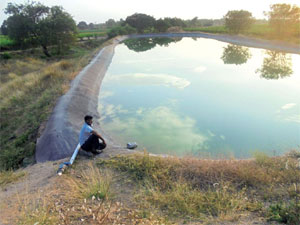(News) Farmers are creating small ponds to irrigate crops in Bundelkhand
Farmers are creating small ponds to irrigate crops in Bundelkhand
 Back-to-back droughts wreaked havoc on agricultural
production and farmers’ incomes across India in 2014-15 and 2015-16. Regions
like Bundelkhand were all the more affected, as the absence of any protective
irrigation cover forced large-scale distress migration of rural residents to
cities, including the national capital. Bundelkhand being one of India’s main
pulses growing belts, the impact of the drought there was also felt through the
sharp spike in prices of legumes.
Back-to-back droughts wreaked havoc on agricultural
production and farmers’ incomes across India in 2014-15 and 2015-16. Regions
like Bundelkhand were all the more affected, as the absence of any protective
irrigation cover forced large-scale distress migration of rural residents to
cities, including the national capital. Bundelkhand being one of India’s main
pulses growing belts, the impact of the drought there was also felt through the
sharp spike in prices of legumes.
One way to at least partly insulate regions against droughts is through constructing of farm ponds on a large scale. Many states — Maharashtra, Madhya Pradesh (MP) and Karnataka, among others — have dabbled with this solution with reasonably encouraging results.
Stopping rainwater run-off and its storage in large man-made tanks/lakes was part of traditional wisdom in Bundelkhand. The region’s Chandela rulers built many such artificial reservoirs such as the Kirat Sagar, Vijay Sagar and Madan Sagar in Mahoba and adjacent areas. But in recent times — especially following the Dewas experiment in MP — the focus has been more on farm ponds. These are farmers’ individual assets, unlike community tanks/lakes that are public assets. Construction of farm ponds requires farmers to set aside a piece of their land for this purpose, which farmers were reluctant to do earlier. But the consecutive monsoon failures are now making them seeing the utility of such assets.
Bundelkhand’s population density, as per the 2011 Census, was 328 persons per square km, below the 828 persons for Uttar Pradesh (UP) and the national average of 382. Average landholding for the region, at 1.43 hectares, is also higher than the 0.76 hectares for the whole of UP. The larger landholdings, plus only a very small area having assured irrigation and recurring droughts, has made its farmers more receptive to construction of farm ponds.
Taking the above facts into account, the UP government conceived a scheme under the Rashtriya Krishi Vikas Yojana, which offers a 50 per cent subsidy to farmers for construction of farm ponds. The cost estimate for a 1,320 cubic meter pond (20*22*3 meters) — which can provide one irrigation for a one-hectare farm — was put at Rs 1.05 lakh. Under the scheme, the farmer would contribute half of this amount, with the government subsidising the balance 50 per cent. At the same time, the farmer was given the freedom to hire the machine for construction himself. Besides, even if he engaged family rather than hired labour, the government would not reduce its absolute subsidy contribution of Rs 52,500. This flexibility gave a huge boost to the speedy construction of farm ponds.
The UP government’s initiative was launched in April this year in all the seven Bundelkhand districts falling in UP: Jalaun, Jhansi, Lalitpur, Hamirpur, Mahoba, Banda and Chitrakoot. Initially, 2,000 farm ponds were sanctioned, of which 500 were earmarked for the worst-hit Mahoba district. The fact that 1,900 ponds got built by end-June before the onset of the monsoon was proof of the farmers’ enthusiastic response to the scheme, in which NGOs and officials also played major roles. Many farmers, in fact, even invested extra money to construct ponds of larger size. Riwai village in Mahoba’s Charkhari tehsil alone saw 25 ponds of 2,000 cubic meters each getting built by farmers.
Read More.....
Courtesy: The Indian Express